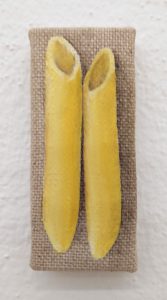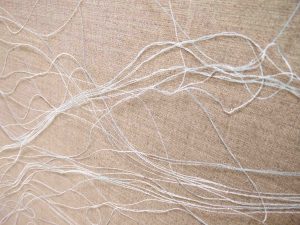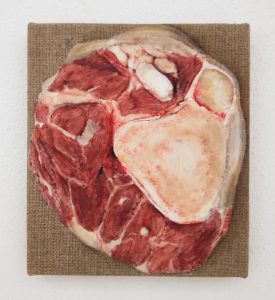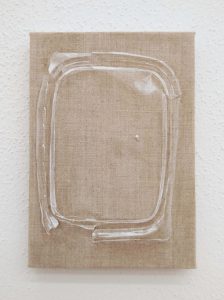 24 September – 5 November 2016
24 September – 5 November 2016
P420
Via Azzo Gardino, 9, off Largo Caduti del lavoro, Bologna
www.p420.it
Helene Appel’s pictorial motifs are – in contemporary painting – unusual, even though they are well known in the history of art and from our daily life. The Gallery P420 currently shows the latest works of this German emerging artist, specifically conceived for the gallerie’s huge space. One could see pieces of broken glass, clogged sinks, fishing nets, meat-cuts and, of course; we are in Italy: noodles.
 The artist choses trivial subjects, to paint them in a sort of hyperrealism, reminding the trompe l’oeil. In consequence, the viewer often cannot avoid approaching the canvas to verify if it is not the object itself that is glued on it. With fine, exact brushstrokes, Helene Appel seems to create an illusion. At the same time, she leaves no doubt about the artificial character, because the canvas of beige linen remains in most cases visible. (vlg. Michael Stoeber) Another way of disassociation is the change of the perspective: usually we see a sink from above; here it is presented frontally. Therefore, the object is isolated from its context, even though it is anchored in the composition of the pictorial space.
The artist choses trivial subjects, to paint them in a sort of hyperrealism, reminding the trompe l’oeil. In consequence, the viewer often cannot avoid approaching the canvas to verify if it is not the object itself that is glued on it. With fine, exact brushstrokes, Helene Appel seems to create an illusion. At the same time, she leaves no doubt about the artificial character, because the canvas of beige linen remains in most cases visible. (vlg. Michael Stoeber) Another way of disassociation is the change of the perspective: usually we see a sink from above; here it is presented frontally. Therefore, the object is isolated from its context, even though it is anchored in the composition of the pictorial space.
Here lies the great difference to the also realistic representations of aliments and everyday objects in the tradition of still lifes: they are depicted in a special surrounding and carry symbolic values. The same is valid for other themes: a seashore is habitually painted with its landscape and not only as a small section. Helene Appel’s practice is to decontextualize her subjects. In fact, it is a double decontextualisation: the motifs are isolated on the canvas and the represented items are not to be expected in a White Cube.
Truly, latest since Marcel Duchamp’s ready-mades it is not unusual to find trivial elements in exhibitions and museums. Nevertheless, Helene Appel’s images don’t seem to transport a message. On the contrary, in her art, it is not the content and its level of meaning what is the subject, but the art of painting itself. Therefore, she is perhaps closer to the Impressionists who showed the brushstroke and gave the canvas an epidermis of colour. Even though the results are closer to photorealism and the linen medium stays visible.
 Helene Appel’s decontextualized motifs went the opposite way than the elements of masterpieces on merchandise articles nowadays. Botticelli’s Venus was primarily created in the context of a painted Greek Mythology and is now displayed on banal objects like cups, bags and umbrellas. This happens to many other important oeuvres of art history, which have now a trivial existence out of their original context. Why than water puddles, noodles and meat cuts should not be canonised to leave their volatile life and enter into eternity?
Helene Appel’s decontextualized motifs went the opposite way than the elements of masterpieces on merchandise articles nowadays. Botticelli’s Venus was primarily created in the context of a painted Greek Mythology and is now displayed on banal objects like cups, bags and umbrellas. This happens to many other important oeuvres of art history, which have now a trivial existence out of their original context. Why than water puddles, noodles and meat cuts should not be canonised to leave their volatile life and enter into eternity?















